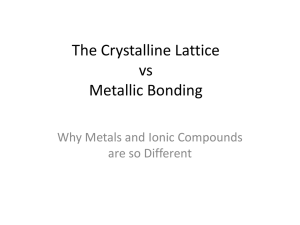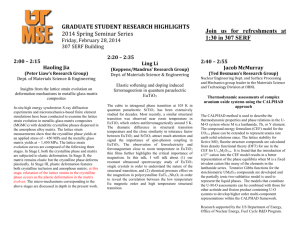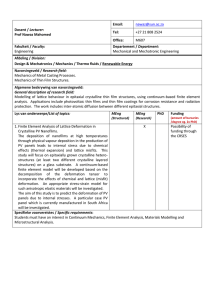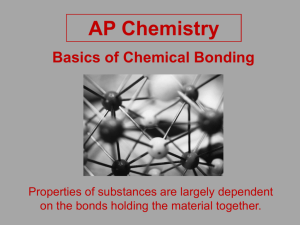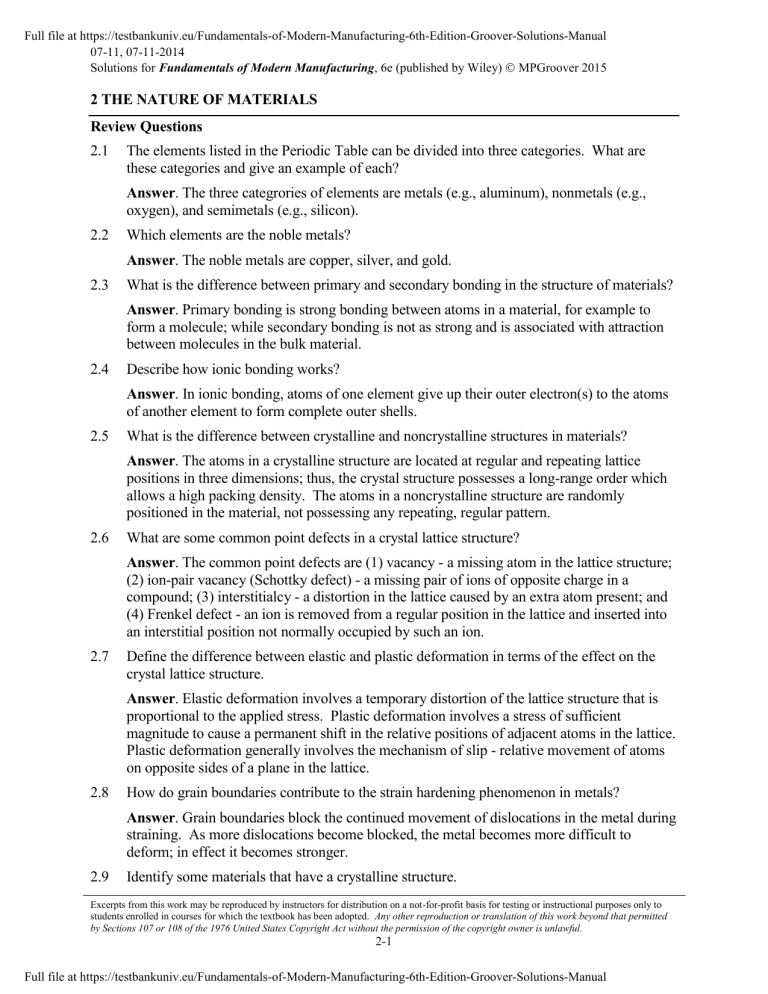
Full file at https://testbankuniv.eu/Fundamentals-of-Modern-Manufacturing-6th-Edition-Groover-Solutions-Manual 07-11, 07-11-2014 Solutions for Fundamentals of Modern Manufacturing, 6e (published by Wiley) MPGroover 2015 2 THE NATURE OF MATERIALS Review Questions 2.1 The elements listed in the Periodic Table can be divided into three categories. What are these categories and give an example of each? Answer. The three categrories of elements are metals (e.g., aluminum), nonmetals (e.g., oxygen), and semimetals (e.g., silicon). 2.2 Which elements are the noble metals? Answer. The noble metals are copper, silver, and gold. 2.3 What is the difference between primary and secondary bonding in the structure of materials? Answer. Primary bonding is strong bonding between atoms in a material, for example to form a molecule; while secondary bonding is not as strong and is associated with attraction between molecules in the bulk material. 2.4 Describe how ionic bonding works? Answer. In ionic bonding, atoms of one element give up their outer electron(s) to the atoms of another element to form complete outer shells. 2.5 What is the difference between crystalline and noncrystalline structures in materials? Answer. The atoms in a crystalline structure are located at regular and repeating lattice positions in three dimensions; thus, the crystal structure possesses a long-range order which allows a high packing density. The atoms in a noncrystalline structure are randomly positioned in the material, not possessing any repeating, regular pattern. 2.6 What are some common point defects in a crystal lattice structure? Answer. The common point defects are (1) vacancy - a missing atom in the lattice structure; (2) ion-pair vacancy (Schottky defect) - a missing pair of ions of opposite charge in a compound; (3) interstitialcy - a distortion in the lattice caused by an extra atom present; and (4) Frenkel defect - an ion is removed from a regular position in the lattice and inserted into an interstitial position not normally occupied by such an ion. 2.7 Define the difference between elastic and plastic deformation in terms of the effect on the crystal lattice structure. Answer. Elastic deformation involves a temporary distortion of the lattice structure that is proportional to the applied stress. Plastic deformation involves a stress of sufficient magnitude to cause a permanent shift in the relative positions of adjacent atoms in the lattice. Plastic deformation generally involves the mechanism of slip - relative movement of atoms on opposite sides of a plane in the lattice. 2.8 How do grain boundaries contribute to the strain hardening phenomenon in metals? Answer. Grain boundaries block the continued movement of dislocations in the metal during straining. As more dislocations become blocked, the metal becomes more difficult to deform; in effect it becomes stronger. 2.9 Identify some materials that have a crystalline structure. Excerpts from this work may be reproduced by instructors for distribution on a not-for-profit basis for testing or instructional purposes only to students enrolled in courses for which the textbook has been adopted. Any other reproduction or translation of this work beyond that permitted by Sections 107 or 108 of the 1976 United States Copyright Act without the permission of the copyright owner is unlawful. 2-1 Full file at https://testbankuniv.eu/Fundamentals-of-Modern-Manufacturing-6th-Edition-Groover-Solutions-Manual Full file at https://testbankuniv.eu/Fundamentals-of-Modern-Manufacturing-6th-Edition-Groover-Solutions-Manual 07-11, 07-11-2014 Solutions for Fundamentals of Modern Manufacturing, 6e (published by Wiley) MPGroover 2015 Answer. Materials typically possessing a crystalline structure are metals and ceramics other than glass. Some plastics have a partially crystalline structure. 2.10 Identify some materials that possess a noncrystalline structure. Answer. Materials typically having a noncrystalline structure include glass (fused silica), rubber, and certain plastics (specifically, thermosetting plastics and some thermoplastics). Excerpts from this work may be reproduced by instructors for distribution on a not-for-profit basis for testing or instructional purposes only to students enrolled in courses for which the textbook has been adopted. Any other reproduction or translation of this work beyond that permitted by Sections 107 or 108 of the 1976 United States Copyright Act without the permission of the copyright owner is unlawful. 2-2 Full file at https://testbankuniv.eu/Fundamentals-of-Modern-Manufacturing-6th-Edition-Groover-Solutions-Manual
